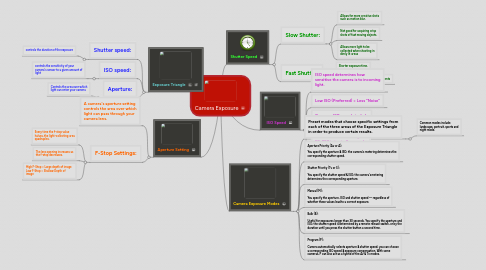
1. Exposure Triangle
1.1. Shutter speed:
1.1.1. controls the duration of the exposure
1.2. ISO speed:
1.2.1. controls the sensitivity of your camera's sensor to a given amount of light
1.3. Aperture:
1.3.1. Controls the area over which light can enter your camera
2. Aperture Setting
2.1. A camera's aperture setting controls the area over which light can pass through your camera lens.
2.2. F-Stop Settings:
2.2.1. Every time the f-stop value halves, the light-collecting area quadruples.
2.2.2. The lens opening increases as the f-stop decreases.
2.2.3. High F-Stop = Large depth of image Low F-Stop = Shallow Depth of image
3. Shutter Speed
3.1. Slow Shutter:
3.1.1. Allows for more creative shots such as motion blur.
3.1.2. Not good for acquiring crisp shots of fast moving objects.
3.1.3. Allows more light to be collected when shooting in dimly lit areas
3.2. Fast Shutter:
3.2.1. Shorter exposure time.
3.2.2. Good for sports/action type movements
4. ISO Speed
4.1. ISO speed determines how sensitive the camera is to incoming light.
4.2. Low ISO (Preferred) = Less "Noise"
4.3. Common ISO speeds include 100, 200, 400 and 800
4.4. For SLR cameras, a range of 50-800 is typically a good choice.
5. Camera Exposure Modes
5.1. Preset modes that choose specific settings from each of the three areas of the Exposure Triangle in order to produce certain results.
5.1.1. Common modes include landscape, portrait, sports and night mode.
